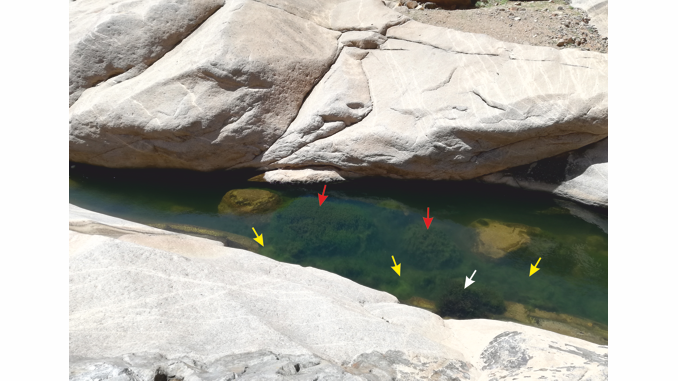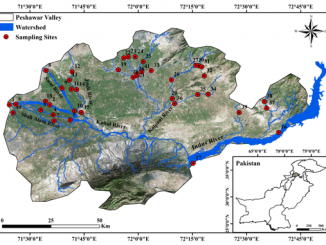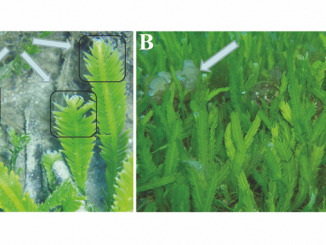
Paper category: Original research paper
Corresponding author: Andrzej S. Rybak (rybakandrzej@interia.eu)
DOI: 10.2478/ohs-2019-0033
Received: 26/04/2019
Accepted: 20/05/2019
Full text: here
Citation (APA style): Rybak, A. & Woyda-Ploszczyca, A. (2019). Ecology and distribution patterns of Chara connivens (Charophyta, Characeae) on the Canary Islands – the first record from Fuerteventura. Oceanological and Hydrobiological Studies, 48(4), pp. 368-380. Retrieved 10 Dec. 2019, from doi:10.2478/ohs-2019-0033
Abstract
The paper presents the first record of a Chara connivens (Characeae) stand from Fuerteventura (Canary Islands, Spain). The species was previously recorded only on Tenerife and Lanzarote, mostly in marine and artificial habitats. Physicochemical parameters of water and morphological features of the thalli and plant community were analyzed. General habitat requirements of
C. connivens populations located in Europe, North Africa, and South-West Asia were reviewed. The newly described stand was located in a natural rock crevice that was part of a riverbed in El Barranco de las Peñitas (Penitas Canyon). This habitat was unshaded and filled with brackish water. C. connivens co-occurred with Cladophora glomerata and Ruppia maritima. Our report on the presence of C. connivens in the Spanish territory of the Atlantic Ocean is the first in almost 40 years. The distribution of C. connivens and its plant associations on the Canary Archipelago are poorly explored, which is why this topic requires further research.
References
APHA (2002). Standard Methods for the Examination of Waters and Wastewaters, 21st ed. USA, Washington: American Public Health Association.
Aboal, M. (1985). Aportación al conocimiento de las algas del SE de España. I. Caráceas (CHARACEAE). Anales de Biología, Biología Vegetal 1: 7–17.
Ahmadi, A., Sheidai, A.M., Riahi, H. & van Raam, J.C. (2012). Some Charophytes (Characeae, Charophyta) from central and western of Iran including Chara kohrangiana species nova. Cryptogamie Algol. 33(4): 359–390. DOI: 10.7872/crya.v33.iss4.2012.359.
Appelgren, K., Snickars, M. & Mattila, J. (2004). Chara connivens Saltzm. ex A. Braun 1835 found in the Aland archipelago – a new species to Finland. Memo. Soc. Fauna Flora Fenn. 80: 11–13.
Barinova, S. & Kukhaleishvili, L. (2014). Diversity and ecology of algae and cyanobacteria in the Aragvi River, Georgia. J. Biodivers. 113: 305–338.
Barinova, S. & Romanov, R. (2015). Charophyte Communities in the Ein Afeq Natural Reserve, Israel. Nat. Res. Conserv. 3(2): 31–44. DOI: 10.13189/nrc.2015.030202.
Becker, R. (2008). Die Armleuchteralgen (Characeae) des Weser-Ems-Gebietes. Rostocker Meeresbiologische Beiträge 19: 43–55.
Becker, R. (2010). Bemerkenswerte Characeen-Funde in Nordwest-Deutschland. Abhandlungen des Naturwissenschaftlichen Vereins zu Bremen 46(3): 409–418.
Becker, R., Blindow, I., Doege, A., Franke, T., Gregor, T. et al. (2016). Beschreibung der Characeen-Arten Deutschlands. Berlin, Germany: Springer Spektrum.
Blindow, I. (1988). Faktablad, kransalger. ArtDatabanken, Swedish threatened species unit. Retrieved August 29, 2019, from http://www.dha.slu.se.
Blindow, I. (2000). Distribution of charophytes along the Swedish coast in relation to salinity and eutrophication. Int. Rev. Hydrobiol. 85: 707–717. DOI: 10.1002/1522-2632(200011)85:5/63.0.CO;2-W.
Blindow, I. (2008). Åtgärdsprogram för bevarande av hotade kransalger. V. Tuvsträfse och barklöst sträfse 2008–2011. Naturvårdsverket, Stockholm. (Rapport 5851).
Bryant, J.A. & Stewart, N.F. (2002). Order Charales. In D.M. John, B.A. Whitton & A.J. Brook (Eds.), The Freshwater Algal Flora of the British Isles. An identification guide to freshwater and terrestrial algae (pp. 593–612). London, GB: Cambridge University Press.
Bryant, J.A. & Stewart, N.F. (2011). Phylum Chlorophyta. Order Charales. In D.M. John, B.A. Whitton & A.J. Brook (Eds.), The freshwater algal flora of the British Isles. An identification guide to freshwater and terrestrial algae (pp. 742–765). London, GB: Cambridge University Press.
Brzeska, P., Woźniczka, A., Pełechaty, M. & Blindow, I. (2015). New records of Chara connivens Salzm. ex A. Braun 1835 – an extremely rare and protected species in Polish brackish waters. Acta Soc. Bot. Pol. 84(1): 143–146. DOI: 10.5586/asbp.2015.010.
Bruinsma, J. (2000). Distribution (1986–1999) of Characeae in the Dutch Province North Brabant. Systematics and Geography of Plants 70(2): 421–427. DOI: 10.2307/3668654.
Bruinsma, J., Denys, L., Krause W., Mes, R., Nat E. et al. (2018). Determinatietabel van Kranswieren van de Benelux. Nederlands: Jeugdbondsuitgeverij.
Cambra Sánchez, J., Álvarez Cobelas, M. & Aboal Sanjurjo, M. (1998). Lista florística y bibliográfica de los clorófitos (Chlorophyta) de la Península Ibérica, Islas Baleares e Islas Canarias. Burgos: Asociación Española de Limnología.
Caraus, I. (2002). The algae of Romania. Studii si Cercetari Univer. Bacau Biol. 7: 1–694.
Caraus, I. (2012). Algae of Romania. A distributional checklist of actual algae. Version 2.3, Romania, Bacau: University of Bacau.
Caraus, I. (2017). Algae of Romania. A distributional checklist of actual algae. Version 2.4. Studii si Cercetari Univer. Bacau Biol. 7: 1–1002.
Cirujano, S., Cambra, J., Sánchez Castillo, P.M., Meco, A. & Flor Arnau, N. (2008). Flora ibérica algas continentales. Carófitos (Characeae). Spain, Madrid: Real Jardín Botánico.
Corillion, R. (1957). Les charophycées de France et d'Europe occidentale. France, Bretonne: Travaux – Laboratoire de Botanique de la Faculté des Sciences d'Angers. DOI: 10.2307/2482664.
DAISIE (2006). Delivering Alien Invasive Species Inventories for Europe. Retrieved August 29, 2019, from http://www.europe-aliens.org/.
Dąmbska, I. (1964). Charophyta. Vol. 16, Poland, Warsaw: Polish Scientific Publishers.
del Arco Aguilar, M.J. & Rodríguez Delgado, O. (2018). Vegetation of the Canary Islands. Plant and Vegetation. Vol. 16. Switzerland: Springer. DOI: 10.1007/978-3-319-77255-4.
del Pozo, R., Fernández-Aláez, C., Fernández-Aláez, M. & Natividad-Felisa, S. (2011). Assessment of eutrophication effects on charophytes in Mediterranean ponds (North-Western Spain). Arch. Hydrobiol. 178(3): 257–264. DOI: 10.1127/1863-9135/2011/0178-0257.
Drake, J.A. (2009). Handbook of Alien Species in Europe. Netherlands: Springer. DOI: 10.1007/978-1-4020-8280-1.
Drobnik, J. (2007). Zielnik i zielnikoznastwo. Warszawa: PWN.
Espinar, J.L., Garcia, L. Garcia, V., Murillo, P. & Toja, J. (2002). Submerged macrophyte zonation in a Mediterranean salt marsh: a facilitation effect from established helophytes? J. Veg. Sci. 13: 831–840. DOI: 10.1111/j.1654-1103.2002.tb02112.x.
Felzines, J.C. & Lambert, É. (2012). Contribution au prodrome des végétations de France: les Charetea fragilis F. Fukarek 1961. J. Bot. Soc. Bot. Fr. 59: 133–188.
Gil-Rodríguez, M.C., Beltrán Tejera, E. & Wildpret de la Torre, W. (1982). Chara connivens Salzm. ex Braun, un nuevo taxon para la flora ficologica de las Islas Canarias. Vieraea 11: 51–56.
Gilroy, P. (2001). Herbarium specimens imaging protocol. New Mexico, USA: University of New Mexico, Museum of Southwestern Biology.
Graham, L.D. & Wilcox, L.W. (2000). Algae. New York: Prentice-Hall, Upper Saddle River.
Guiry, M.D. & Guiry, G.M. (2019). AlgaeBase. World-wide electronic publication, National University of Ireland, Galway. Retrieved August 29, 2019, from http://www.algaebase.org.
Gupta, R.K. (2012). Algae of India. A checklist of Chlorophyceae, Xanthophyceae. Chrysophyceae and Euglenophyceae. India: Botanical Survey of India, Ministry of Environment & Forests.
Heinzel, Gettner, GFN (2010). Monitoring der Qualitätskomponente Makrophyten. Phytobenthos für WRRL und FFH-RL in schleswig-holsteinischen Seen. Endbericht Unveröffentlichtes Gutachten im Auftrag des Landesamtes für Landwirtschaft. Kiel: Umwelt und ländliche Räume.
HELCOM (2013). Red List Macrophyte Expert Group. Baltic Marine Environment Protection Commission – Helsinki Commission, Finland. Retrieved August 29, 2019, from http://www.helcom.fi.
Hy, F. (1913). Les Characées de France. Bull. Soc. Bot. France. 26: 1–47. DOI: 10.1080/00378941.1913.10839719.
John, D.M., Whitton, B.A. & Brook, A.J. (2011). The freshwater algal flora of the British Isles. An identification guide to freshwater and terrestrial algae. Second edition. Cambridge: Cambridge University Press.
Kalmbach, K. (2011). Herbarium plant collection protocol. How to prepare herbarium specimens? USA, Denver: Denver Botanic Garden.
Kautsky, H. & Snoeijs, P. (2004). Baltic Marine Biologists (BMB). In H. Kautsky & P. Snoeijs (Eds.) Biology of the Baltic Sea. Developments in Hydrobiology vol. 176 (pp. 271–271). Dordrecht: Springer. DOI: 10.1007/978-94-017-0920-0-25.
Kostkevičienė, J. & Sinkevičiene, Z. (2008). A preliminary checklist of Lithuanian macroalgae. Bot. Lit. 14(1): 11–27.
Kotta, J., Torn, K., Martin, G., Orav-Kotta, H. & Paalme, T. (2004). Seasonal variation in invertebrate grazing on Chara connivens and C. tomentosa in Kõiguste Bay, NE Baltic Sea. Helgol. Mar. Res. 58: 71–76. DOI: 10.1007/s10152-003-0170-2.
Korsch, H., Doege, A., Raabe, U. & van de Weyer, K. (2013). Rote Liste der Armleuchteralgen (Charophyceae) Deutschlands (3. Fassung). Germany: Haussknechtia, Beiheft.
Krajewski, Ł., Pawlikowski, P., Gutowska, E., Jarzombkowski, F., Kauzal, P. et al. (2015). New data on the distribution and habitat conditions of stoneworts (Characeae) in Poland (2010–2012) including protected areas and lands involved in agri-environmental programmes. Woda-Środowisko-Obszary Wiejskie 15(2): 65–85.
Krause, W. (1969). Zur Characeenvegetation der Oberrheinebene. Arch. Hydrobiol. 2: 202–253.
Krause, W. (1981). Characeen als Bioindikatoren für den Gewässerzustand. Limnologica 13(2): 399–418.
Krause, W. (1997). Charales (Charophyceae). In H. Ettl, G. Gärtner, H. Heynig, H. & D. Mollenhauer (Eds.) Sübwasserflora von Mitteleuropa vol. 18. (pp. 202–210). Stuttgart: Fischer.
Lambert-Servien, E., Clemenceau, G., Gabory, O., Douillard, E. & Haury, J. (2006). Stoneworts (Characeae) and associated macrophyte species as indicators of water quality and human activities in the Pays-de-la-Loire region, France. Hydrobiologia 570: 107–115. DOI: 10.1007/s10750-006-0169-1.
Langangen, A. (2007). Charophytes of the Nordic countries. Oslo: Saeculum ANS.
Langangen, A. (2010). Some charophytes (Charales) collected on the island of Evia, Greece, in 2009. Flora Mediterranea 20: 149–157.
Langangen, A. (2012). Charophytes (Charales) from Crete (Greece) collected in 2010. Flora Mediterranea 22: 25–32.
Ludwig, G. & Schnittler, M. (1996). Rote Liste gefährdeter Pflanzen Deutschlands. Schriftenreihe für Vegetationskunde 28: 1–744.
Luther, H. (1979). Chara connivens in the Baltic Sea area. Ann. Bot. Fenn. 16: 141–150.
Martin, G., Torn, K., Blindow, I., Schubert, H., Munsterhjelm, R. et al. (2003). Introduction to charophytes. In H. Schubert & I. Blindow (Eds.), Charophytes of the Baltic Sea (pp. 3–14). Berlin: Gantner Verlag.
Moore, J.A. (1986). Charophytes of Great Britain and Ireland. B.S.B.I. Handbook No. 5. London: Botanical Society of the British Isles.
Muller, S.D., Rhazi, L. & Soulie-Märsche, I. (2017). Diversity and distribution of Characeae in the Maghreb (Algeria, Morocco, Tunisia). Crytogamie Algol. 38(3): 201–251. DOI: 10.7872/crya/v38.iss3.2017.201.
Nat, E., Simons, J., de la Haye, M.A.A. & Coops, H. (1994). Watersysteemverkenningen 1996 – Historisch en actueel verspreidingsbeeld van kranswieren in Nederland in samenhang met waterkwaliteitsfactoren RIZA werkdocument, Bd. 94. Lelystad: Rijksinstituut voor Integraal Zoetwaterbeheer en Afvalwaterbehandeling.
NOBANIS (2015). The European Network on Invasive Alien Species. Retrieved August 29, 2019, from https://www.nobanis.org/.
Pagad, S., Genovesi, P., Carnevali, L., Schigel, D. & McGeoch, M.A. (2018). Introducing the Global Register of Introduced and Invasive Species. Scientific Data 5: 170202. DOI: 10.1038/sdata.2017.202.
Pełechaty, M. & Pukacz, A. (2008). Klucz do oznaczania gatunków ramienic (Characeae) w rzekach i jeziorach. Warszawa: Inspekcja Ochrony Środowiska. Biblioteka Monitoringu Środowiska.
Reyes-Prósper, E. (1910). Las Carofitas de España singularmente las que crecen en sus estapas. Madrid: Imprenta Artística Española.
Rip, W., Rawee, N. & de Jong, A. (2006). Alternation between clear, high-vegetation and turbid, low vegetation states in a shallow lake: the role of birds. Aquat. Bot. 85: 184–190. DOI: 10.1016/j.aquabot.2006.03.003.
Romanov, R. & Barinova, S. (2012). The charophytes of Israel: historical and contemporary species richness, distribution, and ecology. Biodiv. Res. Conserv. 25: 109–119. DOI: 10.2478/v10119-012-0015-4.
Romanov, R.E., Chemeris, E.V., Zhakova, L.V., Ivanova, A.V. & Palagushkina, O.V. (2018a). The charophytes (Charales, Charophyceae) from the Middle Volga Region (Russia): synopsis of localities and species protection. Nat. Conserv. Res. 3(2): 1–20. DOI: 10.24189/ncr.2018.044.
Romanov, R.E., Patova, E.N., Teteryuk, B.Y. & Chemeris, E.V. (2018b). Charophytes (Charales, Charophyceae) on the northeastern edge of Europe: is it something different across Northern Europe in their diversity and biogeography? Nova Hedwigia 147: 161–182. DOI: 10.1127/nova-suppl/2018/016.
Rybak, A.S. (2015). Revision of herbarium specimens of freshwater Enteromorpha-like Ulva (Ulvaceae, Chlorophyta) collected from Central Europe during the years 1849–1959. Phytotaxa 218(1): 001–029. DOI:10.11646/phytotaxa.218.1.1.
Rybak, A.S. (2018). The Ulva flexuosa complex (Ulvaceae, Chlorophyta): An updated identification key with special reference to the freshwater and hyperhaline taxa. Phytotaxa 345(2): 83–103. DOI: 10.11646/phytotaxa.345.2.1.
Rybak, A.S. &. Gąbka, M. (2018). The influence of abiotic factors on the bloom-forming alga Ulva flexuosa (Ulvaceae, Chlorophyta): possibilities for the control of the green tides in freshwater ecosystems. J. App. Phycol. 30(2): 1405–1416. DOI: 10.1007/s10811-017-1301-5.
Schaminée, J.H.J., Maier, E.X. & van Raam, J. (1995). Charteta fragilis. In J.H.J. Schaminée, E.J. Weeda & V. Westhoff (Eds.), De Vegetatie van Nederland (pp. 45–64). Uppsala: Opulus Press.
Schmidt, D. (1994). Rote Liste der gefährdeten Armleuchteralgen, 1 Fassung. Gernamy: Schwerin.
Schmitz, M.F., Arnaiz-Schmitz, C., Herrero-Jáuregui, C., Díaz, P., Matos, D.G. et al. (2018). People and nature in the Fuerteventura Biosphere Reserve (Canary Islands): socio-ecological relationships under climate change. Environ. Conserv. 45(1): 20–29. DOI: 10.1017/S0376892917000169.
Schneider, S.C., Rodrigues, A., Moe, T.F. & Ballot, A. (2015). DNA barcoding the genus Chara: molecular evidence recovers fewer taxa than the classical morphological approach. J. Phycol. 51(2): 367–380. DOI: 10.1111/jpy.12282.
Schories, D., Selig, U. & Schubert, H. (2009). Species and synonym list of the German marine macroalgae based on historical and recent records. Rostocker Meeresbiologische Beiträge 21: 7–135.
Siemińska, J., Bąk, M., Dziedzic, J., Gąbka, M., Gregorowicz, P. et al. (2006). Red list of the algae in Poland. In Z. Mirek, K. Zarzycki, W. Wojewoda & Z. Szeląg (Eds.), Red list of plants and fungi in Poland (pp. 37–52). Kraków: W. Szafer Institute of Botany, Polish Academy of Sciences.
Simons, J. & Nat, E. (1996). Past and present distribution of stoneworts (Characeae) in The Netherlands. Hydrobiologia 340: 127–135. DOI: 10.1007/BF00012744.
Simons, J., Ohm, M., Daalder, R., Boers, P. & Rip, W. (1994). Restoration of Botshol (The Netherlands) by reduction of external nutrient load: recovery of a characean community, dominated by Chara connivens. Hydrobiologia 275(1): 243–253. DOI: 10.1007/BF00026715.
Skuja, H. (1928). Vorarbeiten zur einer Algenflora von Lettland. IV. Acta Horti Bot. Univ. Latv. 3: 103–218.
Stewart, N.F. & Church, J.M. (1992). Red data books of Britain and Ireland: stoneworts. Joint Peterborough: Nature Conservation Committee.
Temniskova, D., Stoyneva, M.P. & Kirjakov, I.K. (2008). Red list of the Bulgarian algae. I. Macroalgae. Phytol. Balcan. 14(2): 193–206.
Teppke, M., Möbius, F., Schubert, H. & Spiess, H.J. (2015). Rote Liste der Armleuchteralgen (Charophyceae) Mecklenburg-Vorpommerns. Matthias Ministerium für Landwirtschaft, Umwelt und Verbraucherschutz Mecklenburg-Vorpommern. Germany: Schwerin.
Tolstoy, A. & Österlund, K. (2003). Alger vid Sveriges östersjökust – en fotoflora. Uppsala: ArtDatabanken, SLU and WWF.
Torn, K. & Martin, G. (2003). Chara connivens Salzm. ex A. Braun 1835. In H. Schubert & I. Blindow (Eds.), Charophytes of the Baltic Sea (pp. 3–14). Berlin: Gantner Verlag.
Torn, K., Martin, G., Kukk, H. & Trei, T. (2004). Distribution of charophyte species in Estonian coastal water (NE Baltic Sea). Sci. Mar. 68(1): 129–136.
Torn, K., Kovtun-Kante, A., Herkül, K., Martin, G. & Mäemets, H. (2015). Distribution and predictive occurrence model of charophytes in Estonian waters. Aquat. Bot. 120(A): 142–149. DOI: 10.1016/j.aquabot.2014.05.005.
Urbaniak, J. & Blaženčić, J. (2012). SEM study of oospore characteristics in endemic and endangered Balkan Charophytes. Cryptogamie Algol. 33(3): 277–288. DOI: 10.7872/crya.v33.iss3.2012.277.
Urbaniak, J. & Gąbka, M. (2014). Polish charophytes. An illustrated guide to identification. Wrocław, Poland: Wydawnictwo Uniwersytetu Przyrodniczego we Wrocławiu.
van Raam, J.C. & Gonzalez-Henriquez, N. (1995). Note on the Characeae (Charophyta) of the Canary Islands. Bot. Macaronésica 21: 29–36.
van Raam, J.C. (1998). Handboek Kranswieren. Hilversum: Drukkerij De Toekomst, Charaboek.
WCSP (2019). World Checklist of Selected Plant Families. Facilitated by the Royal Botanic Gardens, Kew. Retrieved August 29, 2019, from http://wcsp.science.kew.org.
Wallström, K. & Persson, J. (1999). Kransalger och grunda havsvikar vid Uppsala läns kust: Upplandsstiftelsen. (Stencil Nr 17, 94).
Wood, R.D. (1965). A revision of the Characeae. First Part. Monograph of the Characeae. Weinheim: Verlag von J Cramer.
Zeneli, V. & Kashta, L. (2016). Some Charophyta (Charales) from Coastal Temporary Ponds in Velipoja Area (North Albania). J. Environ. Sci. Eng. 5: 69–77. DOI: 10.17265/2162-5263/2016.02.002.



Bądź pierwszy, który skomentuje ten wpis